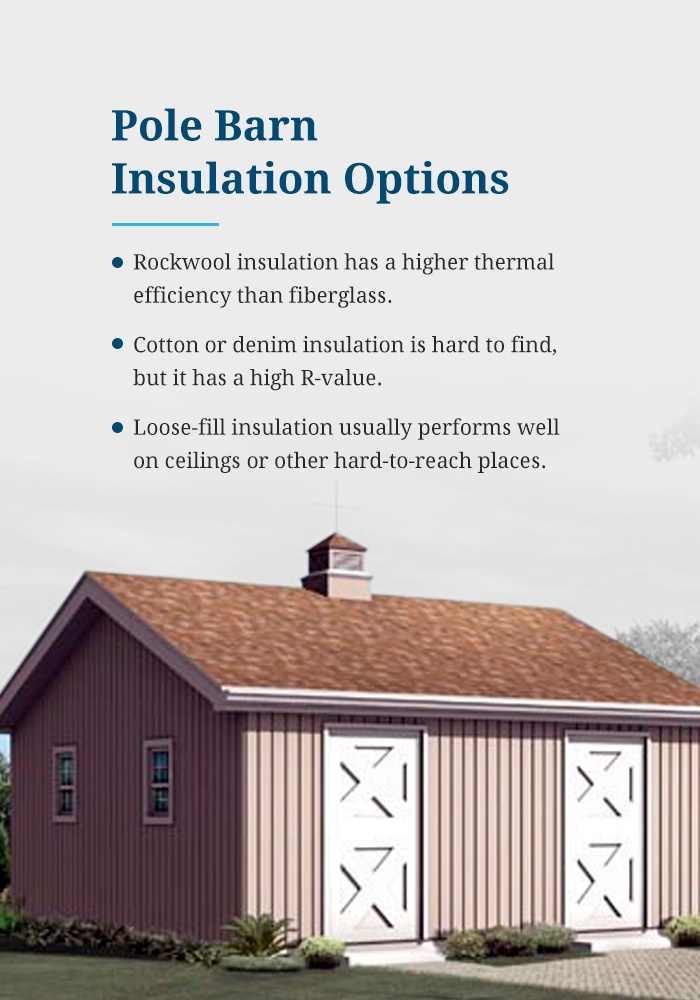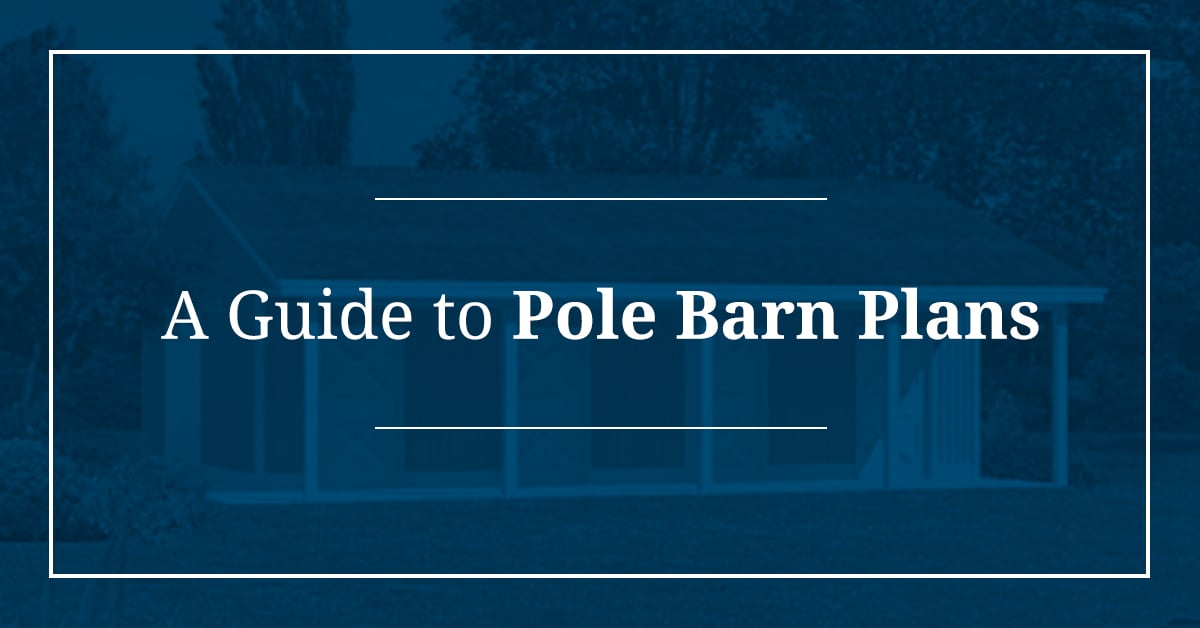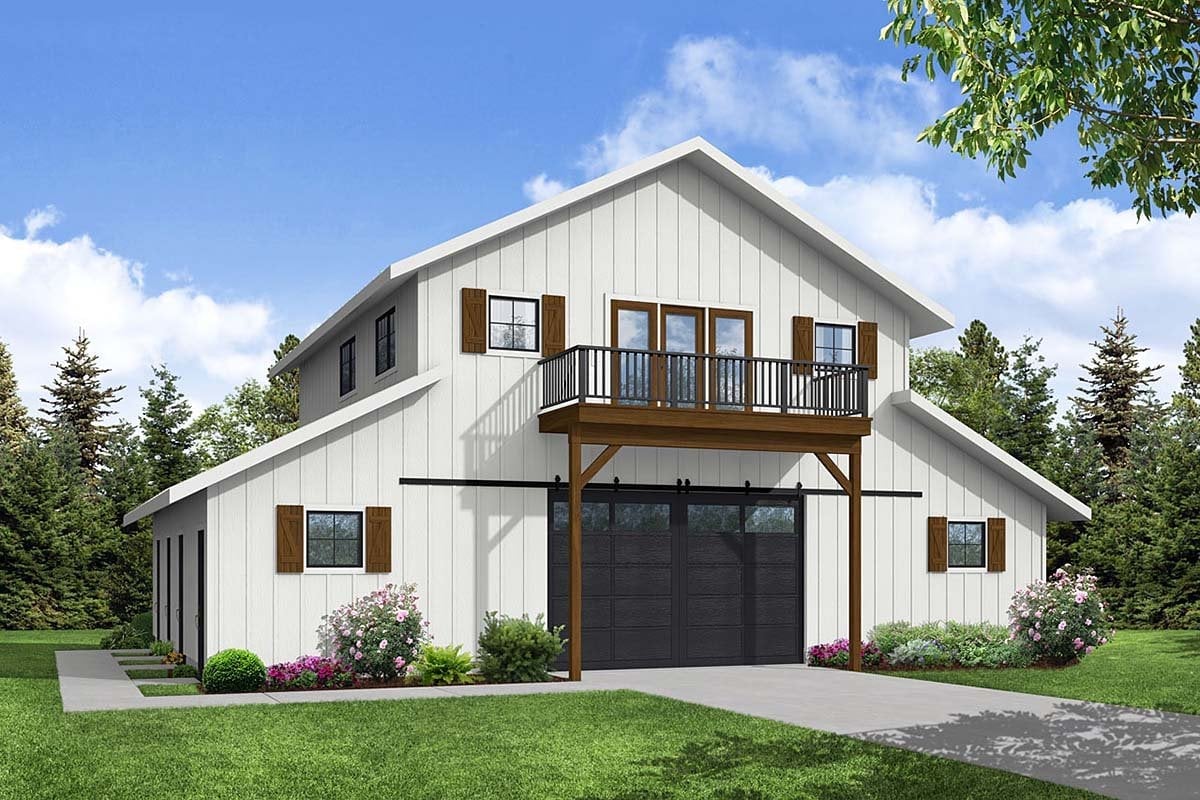A Guide to Pole Barn Plans

If you need more space on your property for your belongings, consider installing a pole barn. You’ll find barns perfect for storing cars, lawn equipment, farm equipment and livestock. Pole barns come in many styles and sizes. You can find an affordable plan that fits the look of your property.
A pole barn is a low-rise system with a wood frame construction. This construction can be home to your horses, or it can be more room for your gardening equipment. Use this guide to explore plans for pole barns to help you create yours.
What Is the Purpose of Pole Barns?
Homeowners can use their pole barn as an area for their livestock and feed. You could also design your pole barn for personal space. The versatility of pole barn blueprints allows you to use your wood frame construction as a:
- Garage or hobby space: The wide doors of a pole barn give you plenty of space to park your car or work on your latest DIY project. You can make a garage out of a simple pole barn design. If you need a place to relax and unwind, build an open floor pole building to make room for your hobbies.
- Office or commercial building: A pole barn that comes with a loft is an excellent place for an office. You could keep your office equipment or stock inventory on the second floor while you work on the main floor.
- Equipment storage or workspace: Pole barns are available in a variety of sizes so that you can fit any type or amount of equipment inside. You can build a pole barn with an open wall to include more space for your tools. A pole barn with a shop area provides an enclosed workspace.

- Livestock or horse barns: You can keep your horses in a personal stable, so they have space to rest after a long day of work. A raised center aisle gives you more room to bring animals into the pole barn. You could add a loft to your pole barn to push hay through the window.
Standard Features of Pole Barn Plans
Pole barns feature poles that stick several feet into the ground. These poles provide vertical support for the frame of the building. The vertical poles connect to wood girts that provide horizontal support.
Pole barn plans depend on how you want to use this space. Barn plans include several design elements in their post frame basics:
- Roof style: You can choose from four common roof styles — gambrel, hip, gable and shed. A gambrel roof gives you more overhead space and extra room for a loft. Hip roofs are flat, which provides a unique look for your pole barn. As the easiest to install, shed roofs usually fit on top of smaller pole barns used for storage. Gable roofs use two sides of the same length that create a symmetrical pattern. The triangular roof allows snow to roll off in the winter.
- Truss: The truss is the frame that will accommodate your roof style. Purlins are the horizontal, vertical and longitudinal structures that brace the truss. The orientation of the purlin boards gives you the roof style you want. You can either have flat purlins, on edge purlins or hung purlins to hold up your roof. You should also choose a design for the truss that accommodates your location’s climate. You want to have a truss that can withstand the weight of heavy snow or harsh winds if necessary.
- Wood frame construction: Pole building framing is more energy-efficient than other building structures. Open wall framing allows more ventilation and makes installing insulation easier. Framing the walls involves both interior wall girts and exterior wall girts. You don’t need to use interior walls, but they will provide additional structural support. You could also add bookshelf girts for a commercial-style pole barn.
- Foundation: Pole barns don’t need a concrete foundation that a traditional dwelling unit does. Builders embed the poles several feet into the ground. The type of foundation you choose depends on your home climate. If you live in a colder environment, you will need to embed your poles past the frost line. You can still add a slab foundation if you want more support for your pole barn. Construct your pole barn on a monolithic slab for protection against the cold.
5 Benefits of Pole Barn Plans

Pole barns give your home more space while enhancing your property’s resale value. You might be able to make extra income by renting your pole barn to a tenant as an accessory dwelling unit (ADU), depending on your location’s regulations. With many designs to choose from, you can create a pole barn however you want. Consider investing in a pole barn to take advantage of these benefits:
- Affordability: Pole building plans are more cost-effective than other types of residential units. The ease of construction reduces the cost of materials and labor. You can also do most of the installation on your own. The posts that hold up the pole building framing drive into the ground. This construction method removes the need for an expensive foundation. A typical foundation for houses involves digging into the ground and pouring concrete. The days you have to wait for concrete drying can delay your project. Instead, you can have a durable pole barn that you can install in much less time.
- Durability: Pole barns last through harsh weather conditions. The force of strong winds and snow travels into the ground because of the poles’ depth. These sturdy poles provide a more reliable construction than other types of buildings. Pole barns are also easier to insulate than wood frame construction or steel frame buildings. This construction can stand without the need for level ground.
- Versatility: Pole barns can serve more purposes than providing shelter for animals. You could create a garage of any size to have space for your vehicles. You could also make an office or a special hangout place with a pole barn. A pole barn can be an accessory dwelling unit with the right permits. You can install a pole barn in any terrain or soil type, so you can construct a pole barn in no time.
- Design flexibility: Pole barn blueprints allow for an open floor plan since it doesn’t need interior walls. You can even design your pole barn with free space to hold more cumbersome items. If your pole barn drawings have an open wall, you can use it for events or even keeping large equipment. Pole barns have a more adaptable design than wood or steel frame buildings. The plan also allows you to make additions in the future, so you can expand as you need more space.
- Quick installation: To construct a pole barn, you need fewer materials than you would need for other buildings. The smaller amount of materials saves you time during installation. You also can install the poles free from a foundation. You can save time that you would use pouring the concrete and waiting for it to dry. They are quicker to finish than steel or wood frame buildings.
3 Pole Barn Plans
The flexibility of a pole barn gives you several options for design. You should configure your pole barn blueprints based on how you intend to use the structure. To provide you with some inspiration for your pole barn building plan, here are three ideas for pole barns:
- Two-stall horse barn: A two-stall horse barn includes a partial slab foundation at the base of the storage unit. Even though it’s compact, this design has extra space for horse feed. The inside of the barn includes a sliding door that leads into the storage area. This sliding door is 6 feet by 7 feet. The footprint is 20 feet by 20 feet. Horse barns keep your horses safe during harsh temperatures and gives them space to rest.
- Open shed pole building: An open-shed pole building can be either 8 feet or 10 feet in height. You could use this space as lofting storage or storage for machinery. Open sheds can also serve as spectator areas for significant events, such as a horse race. This model comes with step-by-step instructions so that you can install this pole barn on your own. The building measures 30 feet by 13 feet.
- Barn with a loft: This model is one of our pole barn plans with a loft. The loft can hold 75 pounds per square foot of live load. If you want two floors of space, a multi-purpose barn will provide you with more room. This pole barn plan comes with step-by-step instructions so that you can construct it on your own. The entire pole barn floor plan measures 26 feet by 48 feet, with 9 feet of ceiling height.
Pole Barn Plans FAQ
A pole barn would be a great addition to your property. You can choose from a designed floor plan, or you can change a floor plan to make it your own. If you still have questions about investing in one, some answers to help you decide.
What Are the Common Sizes of Pole Barns?
A standard pole barn comes in five different sizes:
- 24 feet by 24 feet
- 24 feet by 32 feet
- 24 feet by 40 feet
- 30 feet by 40 feet
- 40 feet by 64 feet
You could also choose a height of either 8 feet, 10 feet or 12 feet. Ceilings higher than 10 feet allow for loft space.
Can You Have a Loft in a Pole Barn?
Homeowners add a second story to their pole barns that can hold up to 100 pounds per square feet. For an agricultural barn, you can keep bales of hay or seasonal tools in the loft. You can use the extra level for more room in your commercial pole barn. If you use your pole barn as a work station or a garage, you can put your tools on the loft for easy access. Pole barn plans with a loft can give you more room for a tenant in an ADU. Consult with your builder to make sure a loft complies with your local building codes.
How Do You Insulate a Pole Barn?

Insulation is efficient to put on the walls of your pole barn. Pole barns don’t need load-bearing walls, so there is more space for insulation between the panels. The broader gaps provide better ventilation, which increases the pole barn’s energy-efficiency. Fiberglass batt is affordable and easy to install. Rockwool insulation has a higher thermal efficiency than fiberglass. Cotton or denim insulation is hard to find, but it has a high R-value. Loose-fill insulation usually performs well on ceilings or other hard-to-reach places.
What Is the Life Expectancy of a Pole Barn?
When you maintain it, your pole barn can last up to half a century. To keep your pole barn clean and sturdy, you need to inspect it for leaks and patch them up as soon as possible. Mowing the lawn near your pole barn could ruin its siding. Keep debris and snow off the roof to prevent it from suffering damage.
Can You Live in a Pole Barn?
The flexible design of a pole barn allows you to create an accessory dwelling unit. Their reliable structure can provide shelter to family members or tenants. In your pole barn drawings, allow enough space for the necessary rooms for a tenant. You can create an open floor plan to give yourself all the room you need. Keep in mind that you will need to get the proper permits to make your pole barn a legal dwelling unit. If you already have a pole barn on your property, some states prevent a second dwelling on the same plot of land. You need to make sure you have the right permits for electricity and plumbing needs. Discuss these details with your builder before you start construction. If you want a structure that will follow state building standards, you can buy a house plan to accommodate your family.
Search Plans for Pole Barns for Your Home With Family Home Plans

The Garlinghouse Company’s selection of pole barns will give you and your family the comfort and space you need. Our team at Family Home Plans will help you design the best pole barn to accommodate your needs.
Install a pole barn on your property to take advantage of its reliability and durability. If you’re ready to create your pole barn blueprints, browse through our selection of pole building plans to add to your home. Our advanced search form gives you the flexibility to choose a floor plan that meets your needs as a family.




Comments (2)
I find it so surprising that pole barns can last up to 50 years with proper maintenance. My grandfather wants to build a barn on his property in the coming months. He has yet to decide the type of barn he wants, so this week I’ll highly recommend that he choose a pole frame barn.
I was thinking of getting a pole barn built next to our hose to use as a shed for all of our gardening tools and other equipment that we need to protect from harsh outdoor elements. It’s good to know that pole barns are specifically designed to be durable enough to withstand harsh weather conditions, so they provide a more reliable construction compared to other building types. I’ll keep this in mind while I look for builders to hire for our pole barn soon.